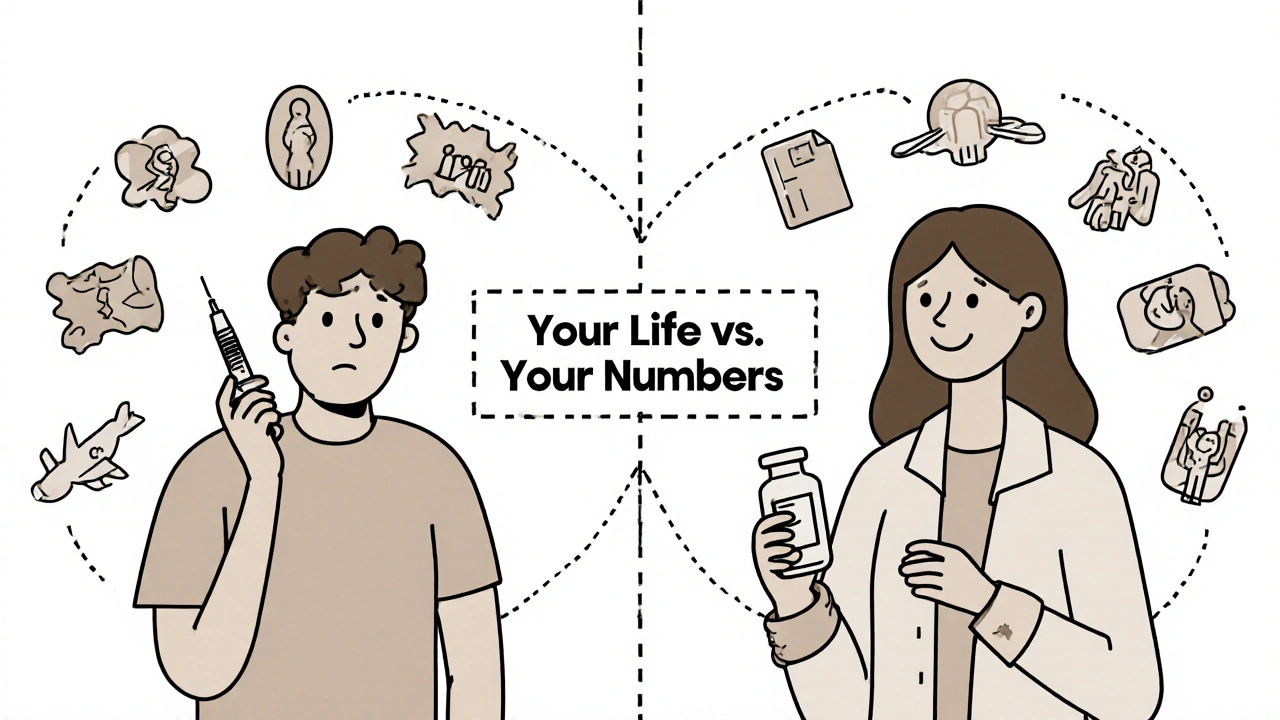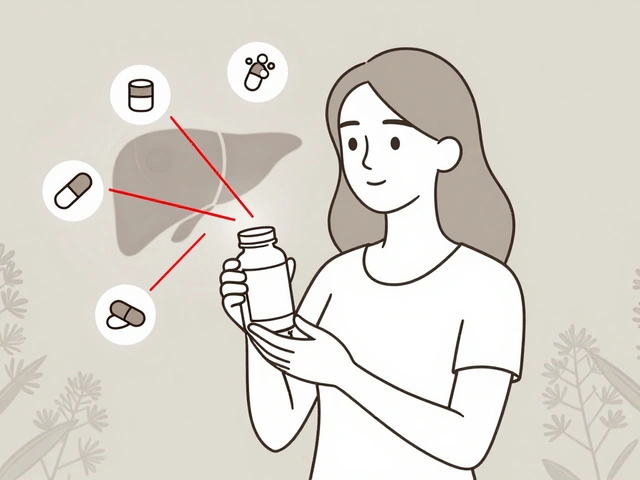When you’re managing an autoimmune disease like rheumatoid arthritis, multiple sclerosis, or lupus, every treatment choice feels heavy. One medication might cut your flare-ups in half-but it could also raise your risk of a rare, life-threatening infection. Another might be easier to take but won’t work as well for your symptoms. And if you’re a parent, a traveler, or someone who works long hours, the side effects might mess with your life in ways no clinical trial ever mentions. This isn’t just about medical data. It’s about your values, your fears, your daily reality. That’s where shared decision-making comes in-not as a buzzword, but as the only way to make treatment choices that actually stick.
What Shared Decision-Making Really Means
Shared decision-making isn’t just your doctor giving you a list of options. It’s not handing you a pamphlet and saying, "Pick one." It’s a two-way conversation where you and your provider sit down, look at the numbers together, and figure out what matters most to you. The goal? To match the science with your life. In the past, doctors made decisions for patients. That model still shows up in about 35% of rheumatology visits, according to the American College of Rheumatology. But for autoimmune diseases, where treatments have serious trade-offs, that approach often fails. Patients stop taking meds because they didn’t understand the risks-or because the treatment didn’t fit their lifestyle. Studies show that when patients are truly involved in choosing their treatment, adherence jumps from 63% to 82%. That’s not a small difference. It’s the difference between staying in remission and ending up in the hospital. Shared decision-making works because it forces both sides to talk. Your doctor brings the evidence: "This drug reduces relapses by 60%, but 1 in 1,000 people get a brain infection called PML." You bring your reality: "I travel for work every month. I can’t handle weekly injections. And I’m scared of anything that lowers my immune system." When those two things meet, you get a plan that actually works.The Tools That Make It Work
You don’t need to be a doctor to understand risk. But you do need clear, simple tools. That’s where decision aids come in. These aren’t fancy apps-though some are-but they’re designed to turn confusing statistics into something you can hold in your hand or see on a screen. For example, the Ottawa Hospital’s decision aid for rheumatoid arthritis doesn’t just say "biologics work better." It says: "With adalimumab, 60 out of 100 people see at least a 20% improvement in symptoms. With methotrexate alone, it’s 50 out of 100." Then it adds: "With TNF inhibitors, 1.8 people out of 100 get a serious infection each year. With methotrexate, it’s 1.2 out of 100." Numbers like that stick. They don’t hide behind percentages or vague warnings. The MS Decisions tool from the University of Michigan does the same for multiple sclerosis. Instead of saying "PML risk is low," it says: "Over two years, 1 in 1,000 people on natalizumab develop PML." That’s not abstract. It’s real. And patients who use these tools report feeling more confident, less anxious, and more in control. One patient on Reddit wrote: "When my rheumatologist showed me the actual numbers, I chose the pill over the shot-even though the shot was more effective-because I travel for work. I didn’t feel like I was being pushed into something I didn’t want." These tools are free. The Arthritis Foundation and the National MS Society both offer downloadable guides for RA, PsA, lupus, and MS. You can use them before your appointment. Bring them in. Say: "I read this. Can we talk about how it applies to me?"
How the Conversation Actually Goes
A good shared decision-making visit doesn’t take hours. It takes about 9 to 14 minutes. And it follows a simple structure:- Team Talk: "I want us to make this decision together. What’s most important to you right now?"
- Option Talk: "Here are the choices. Here’s what they do. Here’s what they might cost you-in side effects, time, money, lifestyle."
- Decision Talk: "Which option feels right for you? Let’s make sure we’re on the same page."
When Shared Decision-Making Falls Short
It’s not perfect. In a flare-up-when your joints are swollen, your vision is blurry, or your legs won’t hold you up-there’s no time for a long talk. About half of neurologists say shared decision-making isn’t practical during a severe MS relapse. You need treatment fast. That’s not the time to debate options. But even then, you can ask: "What’s the safest option to start with? What happens if this doesn’t work? Can we plan the next steps together?" The bigger problem is access. Patients over 65, those with lower health literacy, or people without reliable internet often get left out. Digital tools like the MS Values Compass are great-but if you don’t have a smartphone or you’re not comfortable using apps, they won’t help. That’s why some clinics now pair digital tools with in-person coaching. A nurse or health educator walks you through the options on paper. That’s the kind of support that makes shared decision-making work for everyone, not just the tech-savvy. And then there’s the issue of how risks are presented. A 2017 study found that when doctors say "your risk of infection goes up by 50%," patients think it’s way higher than it is. That’s relative risk. Absolute risk is what matters: "Out of 100 people like you, 2 will get a serious infection this year with this drug. Without it, it’s 1." That’s the difference between fear and understanding.
Why This Matters More Than You Think
This isn’t just about feeling good. It’s about outcomes. People who make decisions with their doctors are less likely to regret them. They’re less likely to stop taking their meds. They spend less on healthcare. In one study, inflammatory bowel disease patients who used shared decision-making saved $3,779 a year on average. That’s not just money. It’s fewer ER visits, fewer hospital stays, fewer missed workdays. And it’s not just about drugs. It’s about your whole life. If you’re a nurse who works nights, you might pick a drug you can take in the morning over one that requires a nightly injection. If you’re trying to get pregnant, you’ll avoid certain biologics-even if they’re more effective-because the risks to a baby aren’t worth it. These aren’t irrational choices. They’re human ones. The American Academy of Neurology and the European League Against Rheumatism now say shared decision-making should be standard for all disease-modifying treatments in MS and rheumatoid arthritis. Medicare is starting to pay for it. The FDA has cleared AI tools that help personalize risk estimates based on your age, lifestyle, and lab results. This is the future. And it’s here.What You Can Do Today
You don’t have to wait for your doctor to bring this up. Here’s how to start:- Before your appointment, go to Arthritis Foundation or National MS Society and download their decision aids.
- Write down three things that matter most to you: mobility, energy, avoiding injections, staying off steroids, being able to travel, etc.
- At your visit, say: "I’ve been thinking about my options. Can we go over the real risks and benefits of each one, and how they match what’s important to me?"
- If your doctor rushes, say: "I know we’re short on time, but I need to understand this fully. Can we schedule a follow-up just to talk about this?"
- Ask: "What would you do if you were me?" That question opens up a lot.
Is shared decision-making only for people with rheumatoid arthritis or MS?
No. Shared decision-making applies to all autoimmune diseases where treatment choices involve trade-offs. That includes lupus, psoriatic arthritis, Crohn’s disease, ulcerative colitis, and even rare conditions like vasculitis. Anytime a treatment has serious side effects, or multiple options exist with different pros and cons, shared decision-making helps you pick the one that fits your life.
What if my doctor doesn’t want to do shared decision-making?
Some providers aren’t trained in it, or they’re pressed for time. That doesn’t mean you can’t ask. Bring printed decision aids. Say: "I’ve read that patients who make decisions with their doctors stick to treatment better. Can we use these tools together?" If they still resist, ask for a referral to a provider who specializes in patient-centered care. Your health is worth advocating for.
Are these decision aids free?
Yes. The Arthritis Foundation, the National MS Society, the Mayo Clinic, and the Ottawa Hospital all offer free, evidence-based decision aids online. You don’t need to pay for them. You don’t need a prescription. Just search for "[your condition] decision aid" and you’ll find them.
Can shared decision-making help me avoid expensive treatments?
Sometimes, yes. Shared decision-making helps you avoid treatments that don’t match your priorities. For example, if you’re young and healthy with mild symptoms, you might choose methotrexate over a $50,000-a-year biologic-even if the biologic works better-because the risk isn’t worth the cost. It’s not about choosing the cheapest option. It’s about choosing the right one for you.
Do insurance companies cover shared decision-making?
Not directly, but they’re starting to. Medicare Advantage plans now tie 9% of payments to patient experience scores, which include how involved patients feel in decisions. The 21st Century Cures Act also requires decision aids for certain Medicare-covered treatments. While you won’t get billed for a "shared decision-making visit," the tools and conversations are becoming part of standard care-and that’s changing how doctors practice.






Corra Hathaway
This is the kind of post that makes me believe in humanity again. 😊 I used to think my rheumatologist was just rushing me out the door, but after using the MS Decisions tool, I finally felt heard. I chose the oral med over the infusion because I travel for work - and guess what? I haven't had a flare in 14 months. Shared decision-making isn't a buzzword. It's survival.
Clifford Temple
Who the hell lets patients decide their own treatment? Next you'll tell me we should let kids vote on their vaccines. This isn't a democracy, it's medicine. Doctors know best. If you can't handle the science, don't be a patient. Just take the shot and shut up.
Julia Strothers
Let me guess - the Arthritis Foundation is funded by Big Pharma, right? And those 'free decision aids'? They're designed to steer you toward expensive biologics so insurance pays more. They don't want you to know about the natural protocols. The FDA cleared AI tools? LOL. AI was trained on data from pharma-sponsored trials. You're being manipulated. Wake up.
jim cerqua
I cried reading this. Not because I'm weak - because for 8 years, my doctors treated me like a vending machine: insert symptoms, get pill. No questions asked. Then one day, my rheumatologist sat down, pulled up the Ottawa tool, and said, 'What do you want your life to look like?' I said, 'I want to play with my daughter without crying.' We picked the pill. I haven't missed a soccer game since. This isn't medicine. This is love.
Donald Frantz
Interesting data. But I'm curious - what’s the dropout rate for patients who use these decision aids versus those who don’t? And how many of those who 'feel more in control' actually stick with the treatment long-term? The 82% adherence stat sounds great, but correlation isn't causation. Are there longitudinal studies controlling for socioeconomic factors? I need the raw numbers.
Swati Jain
As a clinician in Mumbai, I’ve seen this play out differently. In resource-limited settings, 'shared decision-making' often means: 'Here’s the only drug we have - take it or don’t.' The tools you mention? They assume internet access, literacy, and time. In rural India, a nurse reading the pamphlet aloud to a group of 12 patients while a child cries in the corner is the real shared decision-making. Stop romanticizing privilege.
Debanjan Banerjee
Swati’s point hits hard. I work with lupus patients in Delhi - most can’t afford biologics even if they wanted them. But we use paper-based decision aids printed from WHO guidelines. We draw risk charts with pens. We ask: 'Do you want to walk to the market next month, or survive the next year?' Sometimes, the most powerful tool isn’t an app - it’s a pen and a patient’s courage. Also, methotrexate works. Don’t underestimate it.
Shawn Sakura
Man, I’m so glad someone finally said this. I’m a dad with RA. I used to take my meds at 2am because I was scared to miss a dose - but I’d fall asleep at work. My doctor didn’t get it until I showed him the Ottawa tool and said, 'I need to be awake for my kid’s recital.' We switched to a once-weekly pill. I haven’t missed a single school play since. You’re not weak for wanting a life. You’re smart.
Steve Harris
Just wanted to add - if your doctor says they don’t have time, ask for a 15-minute follow-up just for decision-making. Most clinics will do it if you ask. I’ve seen it work. Also, print out the decision aid, highlight your top 3 priorities, and hand it to them at the start. It saves time. And honestly? It makes you look like a partner, not a patient.
Erika Sta. Maria
Shared decision-making? More like shared delusion. You think numbers on a screen mean anything? Life isn't a spreadsheet. My cousin took the 'safer' drug and still got PML. The risk was 1 in 1000 - but it was HER. Statistics don't care about you. They care about averages. You're not a statistic. You're a soul. And no algorithm can replace intuition - especially when your body is screaming.
Florian Moser
One thing no one mentions: shared decision-making reduces malpractice lawsuits. When patients feel heard, they’re less likely to sue - even if things go wrong. It’s not just ethical - it’s legal protection for doctors. Maybe that’s why insurance companies are slowly funding it. Not because they care about you - but because they care about their bottom line.
Nikhil Purohit
For real though - if you're a parent, traveler, or just tired of being treated like a lab rat, this is your manifesto. I’m a software engineer with psoriatic arthritis. I chose methotrexate over the biologic because I don’t want needles in my belly before Zoom calls. My doctor said, 'Smart choice.' No judgment. Just facts. That’s all I needed. Thanks for writing this - it’s the kind of post that makes people feel less alone.